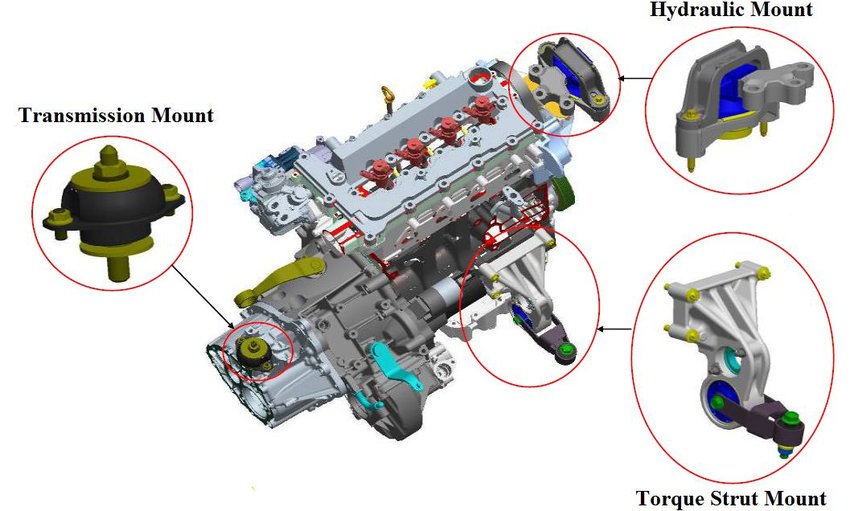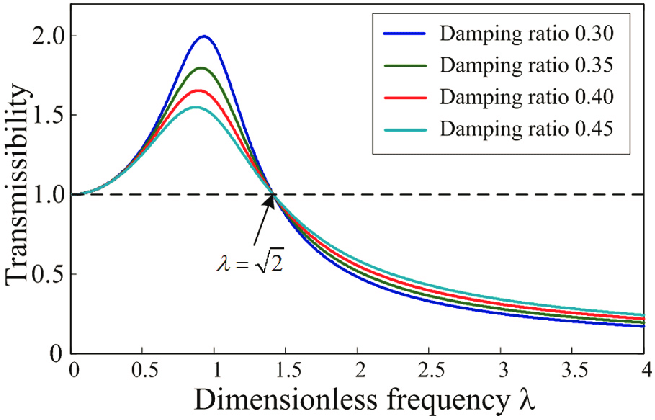Rubber Mountings: Design Considerations, Degrees of Freedom, and Applications
- Post On25.09.2022
- ByNiket Lachake
Introduction:
Rubber mountings play a crucial role in various industries, providing flexibility and damping to control vibrations in machinery and structures. A successful mounting design requires careful consideration of factors such as clearances, stress distribution, metal inserts, and tolerances. In this blog post, we delve into the intricacies of rubber mountings, exploring their behavior as springs, degrees of freedom, and applications in different scenarios.

Degrees of Freedom in Rubber Mountings:
Single Degree of Freedom (DOF):
Within the intricate framework of automotive engineering, the concept of a Single Degree of Freedom (DOF) holds particular significance, especially when it comes to the design and functionality of engine mounts. In this exploration, we unravel the nuanced dynamics of a Single DOF in the context of engine mounts, shedding light on its implications and its role in ensuring a smooth and vibration-free driving experience.
-
Periodic Motion:
Engine mounts, modeled under a Single DOF, exhibit periodic motion as the vehicle encounters various terrains or undergoes acceleration and deceleration. The engine oscillates, returning to its initial position in a repetitive cycle.
-
Resonant Frequency:
Understanding and managing the resonant frequency becomes crucial in engine mount design. Resonance, where external forces match the natural frequency of the engine mount, can lead to amplified vibrations. Design considerations aim to avoid resonant frequencies to ensure a smooth ride.
-
Clearances and Extrusions:
The design of engine mounts involves careful consideration of clearances to prevent damage to the vehicle. Extrusions about static positions, a natural consequence of engine mount dynamics, must be accommodated to avoid potential issues during operation.
Multiple Degrees of Freedom in Engine Mounts:
Real-world engine mounts are complex systems that often operate with multiple degrees of freedom, providing versatility in handling various types of motions. In contrast to the simplified Single Degree of Freedom (DOF) model, which assumes motion in a single direction, engine mounts with multiple DOFs can accommodate a more diverse range of movements. Here's a closer look at the dynamics:
-
Various Degrees of Freedom:
Unlike the Single DOF model, real vibrating engine bodies are concerned with multiple degrees of freedom. These include vertical, longitudinal, transverse, pitch, roll, and yaw. This multi-dimensional flexibility allows engine mounts to adapt to a broader spectrum of driving conditions and terrain variations.
-
Design Flexibility:
Engine mounts can be designed to provide combinations of stiffness and damping in various directions. This design flexibility allows for customization based on specific vehicle requirements. For example, a mount could be soft in all directions, soft in two directions and stiff in one, or stiff in two directions translationally and soft torsionally.
-
Real-world Applications:
Multiple-degree-of-freedom rubber bearings are critical component parts of vehicles, especially in challenging driving conditions. These mounts are engineered to handle sway, surge, yaw, heavy pitch, and roll experienced by the vehicle, ensuring stability and optimal performance.
Resonant Frequency and Transmissibility:

Resonant Frequency:
The resonant frequency, where vibration becomes objectionable, depends on the system's mass, spring rate, and damping coefficient. Designing mounts with resonant frequencies considerably lower than the forcing frequency is crucial.
Transmissibility:
Transmissibility, the difference in vibration amplitude across an isolator, is a key concept. Figure 5.3 depicts a transmissibility curve, highlighting the importance of keeping resonant frequencies low.
Damping and Vibration Absorbers:
Damping converts mechanical energy to heat and affects the system response at or near resonance. Dynamic vibration absorbers, as shown in Figure 5.4, help control vibrations by tuning the frequency.
Design Challenges and Solutions:
Engineering Constraints:
Designing mounts requires achieving specific stiffness (k) and damping (c) values while considering assembly, geometry, size, and cost constraints.
Effect of Damping on Isolation:
Figure 5.5 illustrates how damping impacts isolation and transmissibility at different frequency ratios. Stress Minimization:

Excessive stresses should be avoided, especially in bonded rubber products. Incorporating radii and fillets helps minimize stress concentrations at the rubber-metal interface.
Rubber-Metal Mounts and Deformation Modes:
Versatile Designs:
Rubber's compliant nature makes it ideal for combining with high modulus materials like steel. Various designs, such as conical, spherical, and high-shape factor (Figure 5.7 to 5.11), offer different stiffness and damping characteristics.
Applications:
Rubber-metal mounts find applications in seismic designs, bridge bearing pads, rapid transit, and railroad industry, among others.
Innovative Uses:
Elastomers bonded in ball bearings reduce axial and radial vibration, airborne noise, and accommodate misalignment. Damped drawbars for towing trailers utilize rubber to attenuate noise, shock, and vibration (Figure 5.12).
Conclusion:
Rubber mountings are integral components in controlling vibrations across various industries. A comprehensive understanding of degrees of freedom, resonant frequencies, damping, and innovative designs allows engineers to address challenges and optimize performance in different applications. Careful consideration of these factors, combined with thoughtful design, ensures effective vibration control while meeting engineering constraints and application requirements.
